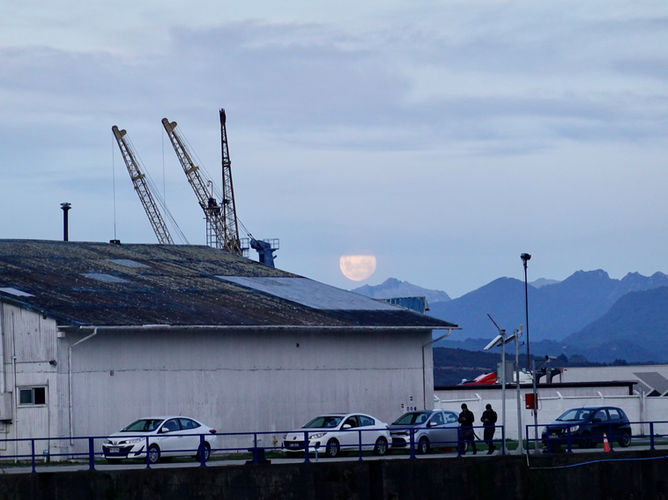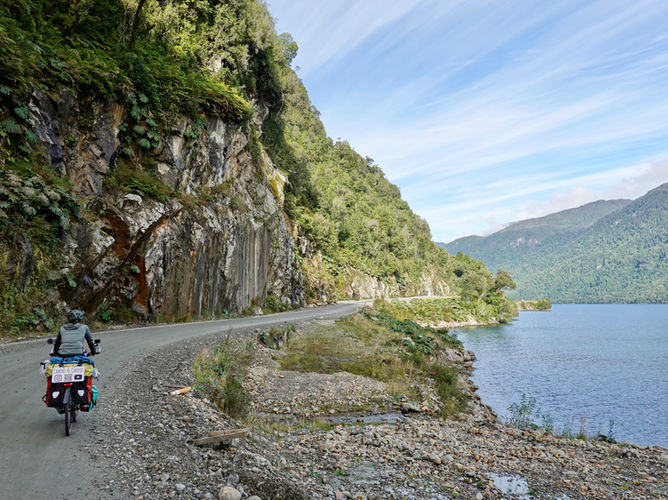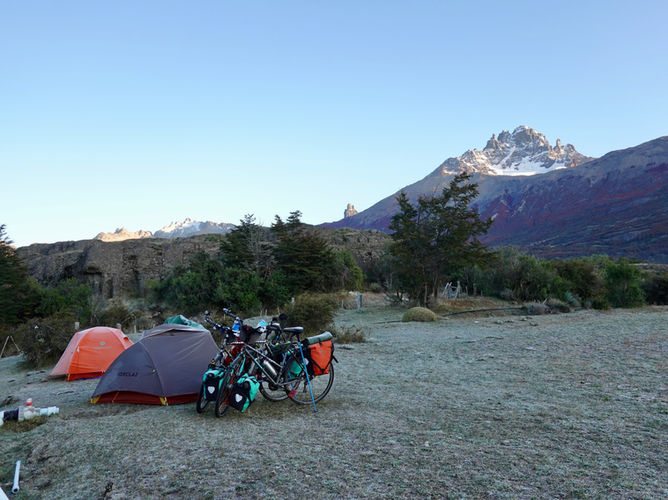
Patagonia
Last updated: October 2023
Overview:

If you are finding our content useful,
we would appreciate a donation via PayPal!
Key Facts Cycling
-
61 days in the region, from 26/03/2023 to 25/05/2023
-
2,365 km / 1,470 mi cycled
-
36 cycling days
-
Overnight stays:
-
Wild camping: 17
-
Other free camping (refugios, villages, etc.): 13
-
Paid campsites: 3
-
Hosts: 1
-
Paid accommodation: 22 (13 nights in Ushuaia)
-
Other (bus, ferries, etc.): 4
-
-
The Route: Villarrica - Puerto Montt - Carretera Austral - Ferry Puerto Yungay to Puerto Natales - Cerro Sombrero - Border Crossing San Sebastián - Ushuaia
-
Our Cycling Highlights: Ruta de los Siete Lagos, Carretera Austral, Tierra del Fuego
Key Facts Region
-
Official name: Patagonia
-
Geographical region that encompasses the whole southern tip of South America
-
Population (2023): approx. 2 million people
-
Area: approx. 1,042,000 km² / 40,2318 mi²
-
Divided between Chile and Argentina
-
Language: Spanish
-
Currencies: Chilean Peso (CLP), Argentine Peso (ARS)
-
Dialing codes: +56 for Chile, +54 for Argentina
-
Famous for its national parks with fjords, glaciers & rugged mountains
Ruta(s) de los Siete Lagos / Seven Lakes Route(s)


-
In the far north of Patagonia, Chile and Argentina share a beautiful region with many rivers, lakes, volcanos & mountains
-
Both countries offer a “Seven Lakes Route”, with the Argentine being the more famous one
-
Our route (Chile): Villarrica - Licanray - Panguipulli - Puerto Squella - Ignao - Crucero - Las Cascadas - Puerto Varas - Puerto Montt (approx. 400 km / 249 mi)
-
Lakes along our route:
-
Lago Villarrica
-
Lago Calafquén
-
Lago Panguipulli
-
Lago Ranco
-
Lago Puyehue
-
Lago Rupanco
-
Lago Llanquihue
-
-
Our highlight: Lago Llanquihue with the snow capped, cone shaped Volcán Osorno
-
The area around Villarrica was quite touristy and busy, so there it was hard to find empty roads and spots to camp
-
Most of the route was along smaller and emptier roads though
-
For camping in the region we often checked iOverlander
-
Argentine Ruta de Los Siete Lagos: San Martín de los Andes - Villa La Angostura - San Carlos de Bariloche (approx. 200 km / 124 mi along Highway 40)
-
Lakes along the Argentine Ruta de Los Siete Lagos:
-
Lago Lácar
-
Lago Machónico
-
Lago Falkner
-
Lago Villarino
-
Lago Espejo
-
Lago Correntoso
-
Lago Nahuel Huapi
-
-
As we didn’t cycle the Argentine route, we can’t speak for it, but from what we’ve heard and read, it’s beautiful
-
Biggest difference between the two routes:
-
Chile: Lakes and Volcanos, runs along the edge of the Andes range; relatively flat surrounding landscape
-
Argentina: Lakes and Mountains, the route runs through the Andes mountain range
-
Carretera Austral


-
Chile's Highway 7
-
1,220 km / 758 mi from Puerto Montt to Villa O'Higgins, incl. four ferry rides
-
Runs through Chilean Patagonia along beautiful fjords, lagoons, lakes, glaciers & mountains
-
Famous among cyclists and other travelers
-
Nicely paved (with some small exceptions) until Villa Cerro Castillo (approx. 770 km / 478 mi), shortly after the village the pavement stops (there are ongoing efforts to pave the whole road)
-
Generally good infrastructure - you'll find some nice cafés, also a sufficient amount of shops to resupply
-
It gets more remote the further south you get
-
No shops between Cochrane and Villa O’Higgins (230 km / 143 mi, incl. a 9 km / 5.5 mi ferry ride) - make sure to carry enough food for the time you need to cover the distance
-
For ‘emergency’ shopping:
-
Tortel is 126 km / 78 mi south of Cochrane, but a 23 km / 14 mi detour (so 46 km / 28 mi round trip) from the Carretera Austral
-
In Caleta Yungay is a tiny cafe which sells some hot drinks, sandwiches & a few snacks; it only opens approximately one hour before ferry departure though (or not at all) and is quite expensive
-
-
Thanks to the many waterfalls, rivers & lakes we didn’t need a town to fill up water
-
We often drank the water right from the stream without even filtering or treating it (depending on what was upstream)
-
We always carry a water filter and chlorine tablets with us to treat water if necessary
-
Copec gas stations provide you with good free wifi and bike maintenance stations
-
Cycling through the National Park Cerro Castillo was one of our biggest highlights, especially because of the autumn colors in April - all the trees were flaming red and in combination with the mountains it was a breathtaking sight
-
The Marble Caves near Puerto Río Tranquilo at the Lago General Carrera / Lago Buenos Aires are worth a visit, but you can only see them by boat (many tour operators are situated at the shore of the lake in town)
-
Camping:
-
We often found good spots on iOverlander (e.g. the donation based Parque Los Rios south of Villa Santa Lucia)
-
But take these spots with caution, some are not as great as described and/or polluted due to the many people using them
-
Many areas along the Carretera Austral are fenced in, making it sometimes hard to find a good spot apart from the known iOverlander spots
-
The further south you go, the easier the camping gets
-
In both Caleta Yungay and Río Bravo you can spend the night in the ferry waiting room (the latter was closed due to maintenance in May though)
-
South of Río Bravo you’ll find a few picnic areas with tables and a roof, we camped at one; there are also two casas de ciclistas / refugios (little huts for cyclists)
-
-
To save some money when getting accommodation, it makes sense to share a cabaña (cabin) with other travelers, as it's charged per cabin and not per person (in Rio Tranquilo we paid 50,000 CLP per cabin/night); they are really cozy
Continuing South after the Carretera Austral


-
The Most Common Route (from what we’ve experienced and heard)
-
Route: Villa O'Higgins - Ferry over Lago O'Higgins/San Martin - Chilean Border Station Candelario Mansilla - Argentine Border Station Lago del Desierto - Ferry over Lago del Desierto - El Chaltén
-
We didn't cycle this route, see our alternative below
-
This route includes two small ferries (private boats), a tough ~15 km / ~9 mi gravel road & a ~5 km / ~3 mi 'hike a bike' section between the two lakes
-
Ferry No. 1 over the Lago O'Higgins/San Martin
-
At the southern shore of the lake the Chilean border station Candelario Mansilla is located
-
At the northern shore of the Lago del Desierto the Argentine border station Gendarmería Nacional Argentina - Grupo “Lago del Desierto” is located
-
Ferry No. 2 over the Lago del Desierto
-
Season: ~November - April
-
The last ferry towards the end of the season left on the 10th of April 2023
-
Generally this service is a bit unreliable, the schedule strongly depends on the weather; so plan with a few extra days in case you have to wait
-
-
El Chaltén in the Argentine Los Glaciares National Park is the first town after Villa O’Higgins; it's famous for the impressive Mount Fitzroy and many hiking routes in the area
-
Cycling further south along Ruta 40, you can do a small detour to El Calafate and visit the Glacier Perito Moreno, one of the few still growing glaciers on earth
-
Then you have two options:
-
Cross back to Chile via Highway Y-205 and the border station Paso Río Don Guillermo to visit Torres del Paine and Puerto Natales
-
Stay in Argentina and follow the Ruta 40 to the border crossing Paso Integración Austral near San Gregorio, where you have to enter Chile again if you want to go further south
-
-
Then you'll reach Tierra del Fuego
-
-
Our Route
-
We arrived end of April 2023 in Villa O'Higgins, so we were too late to catch the boats across the two lakes
-
We cycled back up to Puerto Yungay (108 km / 67 mi north of Villa O'Higgins, incl. a daily running ferry (9 km / 5.5 mi) between Yungay & Río Bravo) and took a 48-hour-ferry from Puerto Yungay to Puerto Natales (learn more here)
-
The two-night-ferry was a great option to get further south and enjoy the beautiful fjords of Patagonia with the surrounding mountains and glaciers
-
We also saw dolphins playing in the wake of the ship
-
-
Highway 265 / Reserva Nacional Tamango south of the Lago General Carrera
-
This option means you have to leave the Carretera Austral after 925 or 970 km / 575 or 603 mi
-
You can either cycle the road 265 along the Lago General Carrera to cross the border at Paso Río Jeinemeni between Chile Chico and Los Antiguos
-
Or you can cycle along the road X-83 through the Reserva Nacional Tamango to cross the border at the Paso Roballo
-
The route through the National Reserve is rather remote:
-
Last supermarket is in Puerto Río Tranquílo
-
Last small tienda (shop) is in Puerto Bertrand
-
First village in Argentina (going south) with a petrol station is Caracoles (according to Google Maps, we can’t verify that you will get any water or supplies there) - 275 km / 171 mi from Puerto Río Tranquílo, 210 km / 130 mi from Puerto Bertrand
-
First town in Argentina (going south) is Gobernador Gregores, 500 km / 311 mi from Puerto Río Tranquílo, 435 km / 270 mi from Puerto Bertrand
-
If you cycle this route, plan accordingly and make sure you can carry enough water and food with you
-
-
-
Paso Mayer
-
A few kilometers north of Villa O'Higgins; from what we heard it's rather a hiking than a cycling route
-
We can’t say a lot about this option and don’t want to give you false information, so best find out more about it on other pages from people who actually took this route
-
Tierra del Fuego


-
Archipelago at the southernmost tip of South America, divided between Chile & Argentina
-
Huge open plains, some beautiful rugged mountains in the south
-
Easy riding on paved roads (according to our planning app only the Y-71 around Porvenir is unpaved, we didn't end up cycling this road though)
-
Two options to cross the Strait of Magellan to reach the Isla Grande de Tierra del Fuego:
-
Highway 257, ferry ride from Punta Delgada to Bahía Azul
-
Ferry from Punta Arenas to Porvenir
-
Find out more: Infrastructure
-
-
The biggest challenge is the wind - Tierra del Fuego is known for its strong (westerly) winds; going south/southeast we had some of the best tailwinds (northwesterly) of our whole journey, but also some of the strongest cross-/headwinds
-
Apparently the wind is already less strong in autumn than in summer, but it was still blowing with around 50 km/h / 31 mph
-
There is no natural place to shelter, just open plains, but in the Chilean part of TdF you'll find several small refugios where you can spend the night (you can see them all on iOverlander, including some recent information and reviews)
-
The Argentine border crossing San Sebastián offers cyclists a warm waiting room to spend the night (with bathrooms next door and even a small gas stove to cook)
Camping & Accommodation
-
Wild camping was occasionally a bit difficult, as many areas were fenced in, too densely forested, too steep or too open & unprotected from the wind
-
We used iOverlander more than we usually do and found some good spots there (as mentioned above, some iOverlander spots are not as great as described and/or polluted though, due to the many people using them)
-
In the Chilean part of Tierra del Fuego many refugios provide you with good shelter for the night
-
Hotels and/or hostels can be found in many Patagonian towns
-
Along the Carretera Austral are several campgrounds, also between towns/villages
Infrastructure
-
As Patagonia is a touristy region, many towns provide you with some type of accommodation, shops and more
-
Many paved roads make for good cycling
-
The tap water in Chile and Argentina is usually potable, except for some really remote regions; we often ask the locals if they drink the water
-
Especially along the Carretera Austral are many waterfalls, rivers and lakes where we often filled up our water bottles
-
Ferries in Patagonia:
-
Due to the many fjords, lakes & rivers in Patagonia, a good ferry system is established in the region, with many routes provided by several different companies
-
Ferry Puerto Montt - Chaitén:
-
Company: Naviera Austral
-
~8:30 hours, from 11 pm to 7:30 am (official sailing time, we only arrived at 9 am though)
-
Runs Monday to Saturday
-
Costs:
-
Commercial rate: 33,000 CLP per person plus 30,000 CLP per bicycle
-
Subsidized rate (applies for three ferries a week, check online): 18,860 CLP per person or 11,110 per bicycle incl. the ‘driver’ (higher prices apply for motorbikes, cars etc.)
-
We bought the tickets online
-
-
-
Ferry Caleta Yungay - Río Bravo:
-
Connects Highway 7 (the Carretera Austral)
-
~1 hour, runs two times a day in low season and three times a day in high season (December to March), not earlier than 10 am
-
No costs
-
In Caleta Yungay is a small cafe that opens approximately one hour before departure; you can get snacks, sandwiches, coffee & tea, but everything is really expensive
-
If you arrive too late for the ferry, you can stay the night in a waiting room in both Caleta Yungay and Río Bravo (the latter was closed due to maintenance in May though)
-
-
Ferry Caleta Yungay - Puerto Natales:
-
Company: Transbordadora Austral Broom
-
~41 hours, from Saturday evening until Monday evening (approx. 700 km / 435 mi)
-
Costs:
-
128,450 CLP per person for foreigners (extranjeros)
-
10,710 CLP per bicycle
-
We bought the tickets online and paid the bicycles at the ship before departure
-
The price included 7 meals (3x dinner, 2x breakfast, 2x lunch) and free coffee and juice all day
-
-
The bikes were tied up on deck, meaning they were a bit exposed to the salt water, but it wasn’t too bad
-
-
Punta Delgada - Bahía Azul:
-
Company: Transbordadora Austral Broom
-
~30 minutes; runs back and forth all day from 8:30 am to 10:30 pm
-
No costs for cyclists
-
-
The former four were the ferries we took; the following three we didn’t experience ourselves, but these connections are also important to know:
-
La Arena - Caleta Puelche:
-
Company: Transportes del Estuario
-
Connects Highway 7 (the Carretera Austral)
-
Runs 24/7 every half hour
-
Costs: Free for passengers without a vehicle; 2,980 per bicycle (incl. the 'driver')
-
You can’t book in advance
-
-
Hornopirén - Caleta Gonzalo:
-
Company: Somarco
-
Connects Highway 7 (the Carretera Austral)
-
It’s actually two ferry rides: Hornopirén - Leptepu (~3:30 hours) & Fiordo Largo - Caleta Gonzalo (~40 minutes)
-
Between Leptepu and Fiordo Largo is a 10 km / 6 mi dirt road section
-
Costs:
-
Commercial rate: 11,000 CLP per bicycle (incl. the ‘driver’)
-
Subsidized rate (applies for the ferry at 10 am from Hornopirén or at 1 pm from Caleta Gonzalo): 7,400 CLP per bicycle (incl. the ‘driver’)
-
It’s advised to buy the ticket in advance, it’s often fully booked
-
-
From what we’ve heard, the dirt road section between the two ferries is problematic for cyclists as you’re only given 30 - 45 minutes to cycle all the way; the ferry company only provides a bus service for people on foot
-
Other cyclists we know of asked other car drivers to take them and the bike to the next ferry
-
-
Punta Arenas - Porvenir:
-
Company: Transbordadora Austral Broom
-
~2:20 hours; runs Tuesday to Sunday only once a day in each direction
-
Costs: 6,800 CLP per person; bicycles may cost extra (only motorbikes are mentioned on the website)
-
-
Other companies and routes:
-
Navimag (runs exclusively between Puerto Montt and Puerto Natales)
-
Transmarchilay Ferries (runs exclusively between Pargua and Charcao, connecting Chile’s largest island Chiloe with the mainland)
-
Transbordadora Austral Broom offers some more routes, e.g. between Punta Arenas and Puerto Williams
-
Naviera Austral also offers more routes, e.g. between Quellón and Puerto Cisnes
-
-
-
Options for leaving (or arriving in) Ushuaia:
-
Fly out (or in) via Ushuaia International Airport Malvinas Argentinas / Tierra del Fuego - Argentina (USH)
-
Take a bus to Río Grande, Río Gallegos (AR) or Punta Arenas (CL):
-
Tecni Austral - we went with this company from Ushuaia to Punta Arenas and everything went well
-
-
Take a ferry from Puerto Williams to Punta Arenas
-
Company: Transbordadora Austral Broom
-
Puerto Williams is a Chilean village on the southern shore of the Beagle Channel
-
To take the ferry, you first have to take another boat from Ushuaia to Puerto Navarino and then a van ride Puerto Williams (usually combined in one offer)
-
In May 2023, we’ve been told that these connections still weren’t offered due to Covid-19
-
It seems like there are some options again now, but the price starts at 120 USD per person
-
We met some other travelers (two of them cyclists) who organized themselves a crossing with a private boat, which also cost them over 120 USD per person
-
-
Spare Part Availability
-
Outside of bigger towns you probably won’t encounter any bike shops
-
Chile:
-
Puerto Montt and Puerto Natales have some basic bike stores/mechanics
-
Punta Arenas has some good shops; we were happy with Bikeservice Patagonia, where we bought some spare parts and got Tobi's hub serviced
-
-
Argentina:
-
El Calafate, Río Gallegos & Río Grande have a few good looking shops (just some examples, there are probably some more towns with bike shops to find)
-
In Ushuaia you'll find a few bike shops as well, at Home Bike we bought several spare parts and had some parts of our drive trains changed; we also got two bike boxes from DTT for the bus ride to Punta Arenas and the flight to Australia
-
Sim Card & Internet
-
Chile:
-
Network providers: Entel, Claro, Wom & Movistar
-
We had a Claro sim card which we bought in a money exchange house in San Pedro de Atacama
-
Unlike in many other countries in Central and South America, Claro isn't the best option to go with in Chile
-
Especially on the Carretera Austral we barely ever had internet, while our Chilean friend often had 3G or 4G with his Movistar sim card
-
Entel and Movistar seem to be the best options to go with
-
For fast free WiFi on the road go to the Copec gas stations
-
-
Argentina:
-
Network providers: Claro, Movistar & Personal
-
We didn’t buy a sim card in Argentina, so we can’t speak from experience
-
Claro seems to be a good option especially for Patagonia; apparently there is even good connection in rather remote parts of the region
-
Climate & Weather
-
Generally Patagonia has a rather cool climate as it’s so far south
-
Four distinct seasons
-
Spring: (mid.) September - November
-
Summer: December - February (peak season)
-
Autumn: March - May
-
Winter: June - August/mid. September
-
-
The temperatures are higher along the coast than they are inland, with the east coast (Atlantic Ocean) being warmer than the west coast (Pacific Ocean)
-
Average annual temperatures range from 4 - 13 °C (40 - 55 °F), with the maximum temperature reaching about 34 °C (93 °F) and minimum temperatures between −9 and −33 °C (16 and −27 °F)
-
Annual average precipitation ranges from 120 to 200 mm (5 to 8 in), even though up to 480 mm (19 in) have been recorded
-
The rainfall is much higher west of the Andes, the central areas of the region have a more arid climate
-
Strong west winds occur in the region
-
We cycled through Patagonia in Autumn and were expecting rainy days and cold temperatures, but were surprised by many sunny days and temperatures above 10°C on some days (not usual)
-
The mornings & evenings were freezing cold though and the days were short
Border Crossings
-
Most cyclists zigzag between Chile and Argentina after the Carretera Austral, crossing at these borders:
-
Chilean Border Station Candelario Mansilla & Argentine Border Station Lago del Desierto
-
Torres del Paine or San Gregorio (two route options, mentioned in Tierra del Fuego)
-
San Sebastián (as mentioned above, this border has a warm waiting room where cyclists can spend the night!)
-
-
We only crossed twice at San Sebastián (once by bike, once by bus)
-
With our German passports we got 90 days for both Chile and Argentina without having to apply for a visa
-
No entry costs
-
Some documents to fill out beforehand for Chile
-
Chile was the first country where we had to fill out customs documents for our bikes (the 90 days also apply for the bikes)
-
When entering Chile, your luggage might be checked
-
Always check regulations before entering the country as they might change on short notice
Safety
-
Generally we felt safe, but we always try to stay hidden when camping
-
Big cities are potentially more dangerous, just be cautious and inform yourself about areas you better avoid; we didn't have any dangerous situations
-
Hardly any dog problems
-
The drivers were mostly considerate
-
Only on the last part between Río Grande and Ushuaia we were often overtaken carelessly with too little distance and too much speed
-
Emergency numbers Chile:
-
Police (Carabineros de Chile): 133
-
Ambulance (Ambulancia SAMU): 131
-
Firefighters (Bomberos): 132
-
-
Emergency numbers Argentina:
-
Central Emergency number (Central de Emergencias Nacional): 911
-
Ambulance (SAME): 107
-
Firefighters (Bomberos): 100
-
Cash & Expenses
-
Chile:
-
Compared to most of the other South American countries, Chile is quite expensive, especially in remote and touristy regions like Patagonia
-
Exchange rate Oct. 2023: 1 EUR = 995 CLP / 1 USD = 930 CLP
-
Payment by card is often possible, provided there is internet
-
When paying by card, the cashiers always ask 'Débito o Crédito?' - our Revolut visa cards, which usually count a credit cards, counted as debit cards in Chile
-
When choosing 'Crédito' while paying by card, we were charged a small fee, with 'Débito' it was free
-
Always take enough cash with you
-
Almost all ATMs charge an 8,000 CLP fee for cash withdrawal, the only free withdrawals we made were with the Scotiabank ATMs
-
-
Argentina:
-
Argentina had an inflation of over 100% when we were there (May 2023)
-
Two rates:
-
Official rate, applies when you pay with card
-
Exchange rate Oct. 2023: 1 EUR = 369 ARS / 1 USD = 350 ARS
-
-
Unofficial blue rate:
-
This rate applies when you exchange USD (or EUR) for the ARS
-
In May 2023 we got twice the amount of ARS compared to the official rate, so you can save a lot of money
-
You even get this rate when sending money for cash pickup via WesternUnion (which we can definitely recommend)
-
Blue exchange rate Oct. 2023: 1 EUR = 1,030 ARS / 1 USD = 975 ARS
-
Means you have to carry huge packs of cash around with you though
-
-
-
-
ATMs are called Cajero Automático in Spanish
Tourism
-
Rafting is popular in Patagonia, a cyclist we met went rafting in Futaleufú and really liked it
-
Nationalpark Los Glaciares, Argentina:
-
One of Argentina’s biggest tourist attractions
-
Features several glaciers that originate in the great Patagonian Ice Field, the second largest ice sheet in the world (after Antarctica), which occupies almost half of the Park
-
Highlights:
-
Glacier Perito Moreno, accessible from El Calafate
-
Mount Fitzroy, accessible from El Chaltén
-
-
Entry fee (Oct. 2023): 12,000 ARS
-
Opening times:
-
Summer (01. Sept. - 30. Apr.): 8 am to 6 pm
-
Winter (01. May - 31. Aug.): 9 am to 4 pm
-
-
-
Nationalpark Torres del Paine, Chile:
-
Chile's main tourist attraction, famous for its hiking routes through breathtaking landscapes
-
The park is open all-year round, but in winter (May - September) you can only enter the park with a certified guide
-
Peak season is in summer, from December to February
-
Two main hikes:
-
O-Circuit - approx. 120 km / 74 mi, open from 01. Nov. - 31. Mar., possible without a guide, campground reservations are mandatory
-
W-Circuit - approx. 80 km / 50 mi, open from 01. Oct. - 25. Apr., possible without a guide, campground reservations are mandatory
-
-
Tobi hiked the W-Circuit in December 2018 and loved the landscapes, but it was quite busy
-
-
Puerto Natales, Chile, is a cute town, but very touristy (it's the closest town to Torres del Paine)
-
Parque Pingüino Rey, Chile:
-
A colony of King Penguins has settled in Tierra del Fuego, east of Porvenir, in 2010
-
You have to book a tour online, it costs 12,000 CLP per adult
-
Opening times in low season are from Thursday to Sunday - unfortunately it was closed when we were there
-
It's completely closed from June to September
-
-
Ushuaia, Argentina:
-
'El Fin del Mundo' / 'The End of the World'
-
A touristy, but nice town
-
Depending on the season, you can do different (boat) tours in the area
-
May 2023: We did a boat tour in the Beagle Channel and were lucky to see several humpback whales (even though it wasn't a designated whale watching tour)
-
We stayed two weeks in a really affordable Airbnb, 3 km / 1.9 mi from the center
-





















































